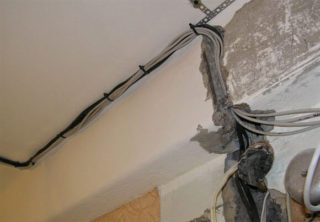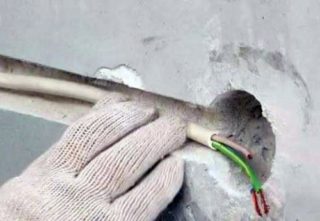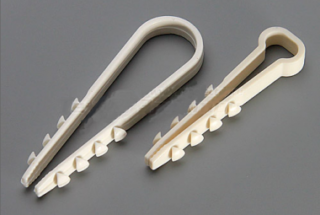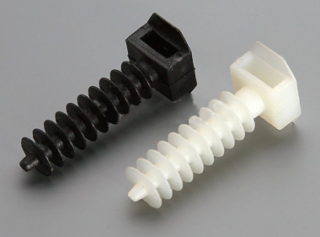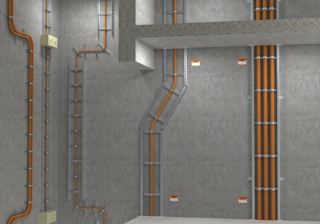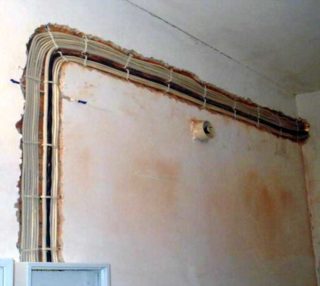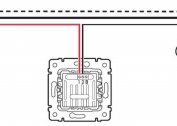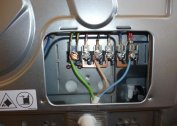The strobes are grooves made in the walls. They carry out the laying of electrical and utility networks. It is necessary to fix the wire in the strobe in order to protect it from mechanical damage, preserve the aesthetics of the interior. In corpulent and hollow surfaces, holes are made with special tools, and the cable is fixed in several ways.
General rules for fixing the cable in the gate
Safety rules note that in residential, public buildings and in production it is necessary to install wiring with non-combustible insulation or in a box made of solid metal. Experts provide several universal recommendations:
- the main objective of the fastening is to ensure the reliability of fixation without sagging;
- on turns of the track fasteners can be moved 5-10 cm from the bend point;
- screws, screws and dowels are tightened for stop - so the protruding cap will not damage the insulation layer;
- fastening is made with a maximum distance between points of 50 cm;
- styling is done strictly in a vertical or horizontal line, the stock is masked;
- the wire before finishing with plaster is placed so that it does not interfere with the coating;
- in the presence of a stretch or false ceiling, gating is not performed;
- for installation use a drill, hammer, hammer and screwdriver.
The stock of cable can be rolled into a ring.
How to fix a wire in a strob
After the preparatory work, you will need to think about how to securely fix the wire laid in the strobe. There are several methods.
Alabaster
Building gypsum mixture is used if it is necessary to fix the wiring in the furrows. Alabaster will hold well the minimum number of cables with soft insulation. The composition is superimposed in small portions. The disadvantage of this method is the quick setting of the mixture, so it cannot be prepared in large quantities.
Dowel clamps
Products are available in black and white for cable diameters of 19-15 mm, 5-10 mm and 11-18 mm. Polyamide fasteners are 6 mm in diameter and is a loop with clamps at the lower ends. Before using the dowel clamps, you will need to make a groove with a perforator, put the fasteners and fix the wiring. The disadvantage of technology is a strict selection of cable diameter for the size of dowel clamps.
Wall plugs
The product looks like a dowel-nail, combined with a cable tie, made from self-extinguishing type plasticizers. The expansion bolt shield couplers are equipped with demountable and one-piece locks. In the first case, the master can add or remove wires. It is used for open and hidden installation of a single or bundle cable line on brick, concrete and other surfaces.
To fasten the wire with the dowel-tie, you will need to put the tie in the drilled strobes and fix it with the expanding peg. The cable is laid in an open product. The screed is pressed.
Dowel clips
Suitable for open laying communications on drywall or when performing retro-finishing. The fastener is a curved plastic strip with elastic branches at the ends. These elements hold the latch. The clips are suitable for mounting a flat or round conductor with a small cross section (television, telephone, for connecting the Internet).
Install the dowel clip is easy. You will need to drill a niche of the desired diameter, insert a tourniquet into the clip, tucking its ends into the hole.The element is inserted into the hole with force. Electrical communications look neat and do not interfere with operation.
Cable ties for dowels
Modifications in the form of an expansion bolt shield with a carving and a platform coupler. An element made of non-combustible plasticizer or nylon can be easily mounted on aerated concrete, wooden, brick or concrete walls. Compatible with screws, screws, self-tapping screws, standard and dowel nails.
Before installation, make a hole for the diameter of the fastener. First, the dowel is placed, then the cavity in the screed and the base are combined. Then the screed-platform is hammered and wound, and the wires are laid on the finished track.
Plastic expansion bolt shield
Polyamide dowels for a screed with a rectangular head-hole allow you to fix the wire without problems. The element will need to be hammered, and then the wire will be pulled through the head. It is firmly and firmly fixed in the gate.
Aluminum plates
Most often, cut strips of thin metal are used. Several cables are wrapped with a plate, which is then drilled through and attached to the bottom of the strobes on the dowel-nails.
The strip is punched exclusively in the center, and the strip of cable is laid on top of it. After placing the wiring, the ends of the box are bent.
Fixture for arranging a bundle of conductors
Not all types of wires are fixed permanently. Problems arise when equipping a workplace where it is necessary to carry out lighting, the Internet, and connect a PC. Special wire holders exclude holes from nails and screws, allow you to quickly transfer communications. There are several types:
- Cable clip with double-sided adhesive tape on the back. Suitable for installing wires on furniture or plastic panels.
- Assembly site. To fix the wire, first fix the pad with the sticky part. The bundle is attached to the holes with a standard screed.
- Cable trays. Made of galvanized wire or perforated metal. They are used if you need to fix the wires to the ceiling.
Trays can be used in contact with combustible materials.
Homemade appliances
If there is no specialized fastener at hand, home craftsmen use improvised material:
- Dowels or nails. Mounting is done before laying the wires. A dowel or a nail punch a piece of telephone cable in the center and screw another.
- Gofroshlang. It will take a piece longer than the width of the line. The corrugated hose is squeezed a little and put into the groove. Fasteners may be removed as the plaster layer is applied.
- Perforated stripes. The technology is suitable for Khrushchev and provides for the fixation of segments with perforation with dowels across the pipe. In this way, bundles of wires can be attached.
- Staples made of galvanized sheets. The material must be cut into strips 1 cm thick and bent staples. Products are suitable for cable fastening on the walls, ceiling. They are arranged in increments of 50-80 cm and are tacked by nails.
Home-made fasteners are easy to manufacture, can save money on the purchase of special consumables, installed multiple times, high-quality fixes a single wire and bundle.
How to lay a wire
The surface is chipped before laying the cable. They work with a puncher with a special nozzle-strobers in the form of a curved shovel with a groove. The standard spatula also provides deep coverage. Incisions to the desired depth can be done with a grinder, and the central parts can be knocked out with a puncher.
Closed technology
Most often, the installation of wiring in the gate is carried out in a hidden way.The strobe is organized if the room has not yet been finished.
Cable products can be fixed:
- couplers - dowel or installation sites;
- clips for section size;
- on suspensions or inside GKL ceiling profiles;
- in trays when laying several bundles.
At the stage of repair work, the wire can be laid inside the walls, floor or ceiling.
Using the open method
The conductors should be fastened so as to preserve the aesthetic appearance of the finish. There are several tricks for this:
- cable channels - plastic trays fixed along the wall surface;
- special skirting boards - texture “wood-like” will fit perfectly into the interior;
- staples and clips - are installed with a stapler, painted in the tone of the wiring.
Open wiring is suitable for loft, retro or provence rooms.
After laying the cable, the dust and debris are completely removed from the strob, they are passed through them with a special primer. After waiting for the tool to completely dry, the strobes need to be plastered, and after a while to putty. Compliance with safety precautions and the correct selection of fasteners exclude damage to the wiring during decoration and operation.
